
Karen Ranara
Early Careers Writer

We recently discussed our findings in a presentation. Below, you'll find an overview of key trends and our recommendations on how to navigate them.
2. Tips for responding to these trends📈 Applications are up significantly year on year
❄️ July, August are key months for recruiting
✍️ Pre-registrations are popular with students
🏦 Banking & Financial Services is the most popular sector🖥️ IT, Engineering students are searching for more jobs
🎓 Students want more internships
🏞️ Students are increasingly interested in regional roles
🎯 Students prioritise location, timely response, salary
❓ Ineligibility, lack of clarity deter students from applying
The trends
Prosple New Zealand saw a 149% increase in applications this year, up from 17% last year.
Total job applications
Part of this heightened demand comes from the fact that students are applying for more jobs.

What explains this surge? One contributing factor is the 81% increase in students using Prosple NZ.
Students using Prosple NZ per month

According to the NZAGE Graduate Survey data, the projected number of job applications per student for this year is 27, reflecting a 34% increase compared to previous figures.
Students are applying for more jobs

In sum, more students are using Prosple, and they are applying for more jobs than before.
- A higher number of employers posting job listings
- Enhanced promotion of Prosple through social media campaigns, SEO efforts, and the launch of the 2024 Top 100 Guide
Applications are trending upward for each month, with July and August emerging as key months for recruiting.
In 2023, more students applied to jobs during these months than in March – though March remains critical, as we can see with the 118% increase in applications year over year.
Application numbers by month

More students also searched for jobs during July-August than in March of last year.
Job searches per month

- Second-round recruitment: Many clients returned to the job market during these months to fill roles that remained vacant after their initial recruitment efforts.
- Internship season: July and August are prime months for internship recruitment, with a growing number of companies offering intern programs and an increasing interest from students in these opportunities.
Employers post jobs just 1-2 times a year, while students search year-round, leaving much talent untapped.
To bridge this gap, we started giving students the option to ‘pre-register’ for jobs. This allows them to sign up for a specific job posting before it’s live.
By offering students early access to job postings, pre-registrations not only support your future campaigns but also enhance overall engagement during periods when you're not actively recruiting.
Since launching the new feature, pre-registrations on Prosple New Zealand have tripled, showing students’ interest in registering for jobs in advance.

🏦 Banking & Financial Services is the most popular sector
- Banking & Financial Services
- Accounting & Advisory
- Technology
Applications by industry sector

🖥️ IT, Engineering students are searching for more jobs
- Engineering & Mathematics
- IT & Computer Science
Search trends by study field

Students in these fields are also applying to jobs in a greater variety of sectors.
While they still applied to the most jobs in Engineering Consulting and Technology, the share of applications going to these sectors has decreased significantly.
Top industries for Engineering & Mathematics students, by application
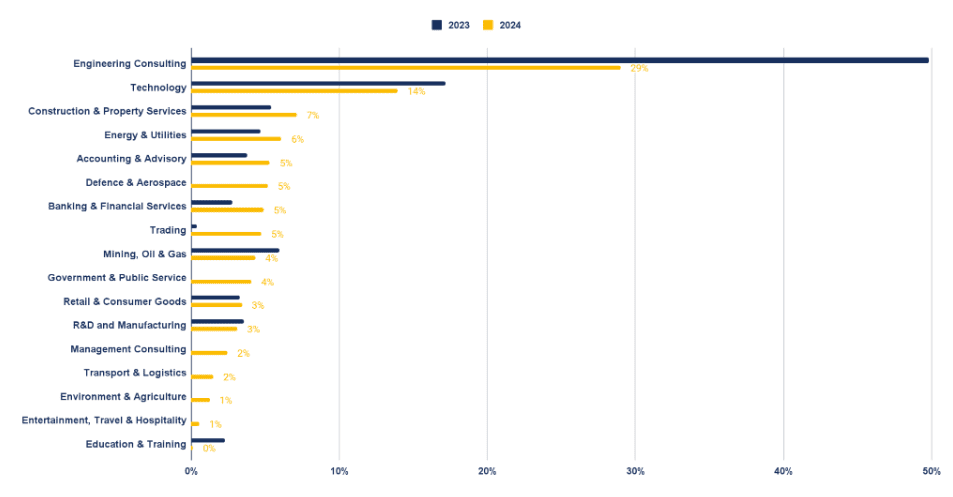
Top industries for IT & Computer Science students, by application
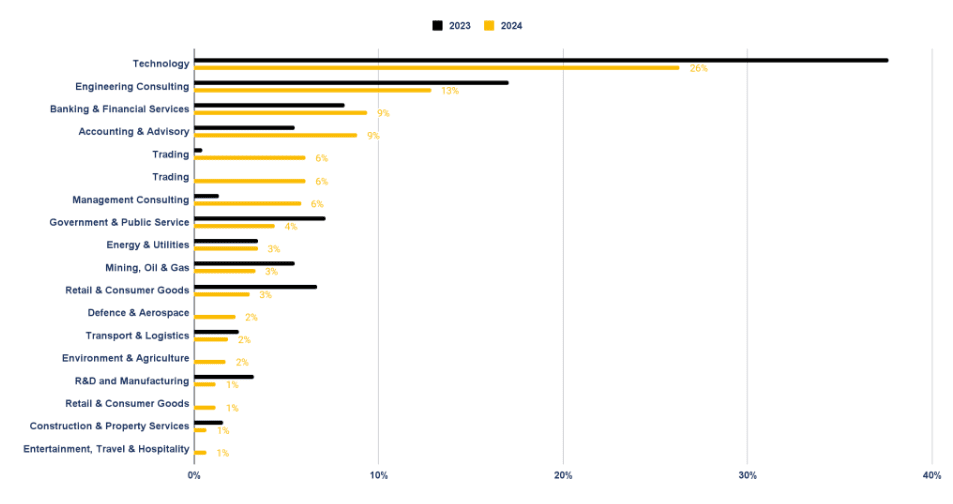
- Construction & Property Services
- Energy & Utilities
- Accounting & Advisory
- Banking & Financial Services
- Accounting & Advisory
- Banking & Financial Services
- Management Consulting
Over the past three years, students are increasingly seeking internships before graduating.
What jobs are students applying for?
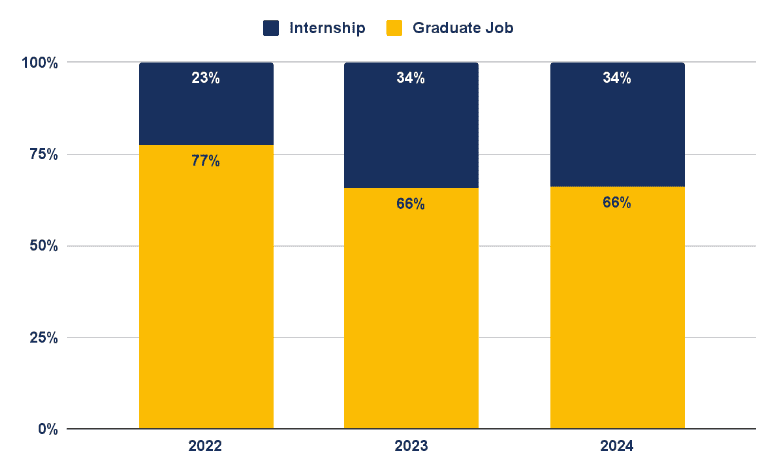
Students understand that internships not only build their resumes but also increase their chances of securing a full-time position. By interning at a preferred employer, students can demonstrate their value and improve their prospects of being hired.
While Auckland and Wellington are still the most popular destinations for students, fewer students want to work in these cities compared to last year.
Preferred work locations for students
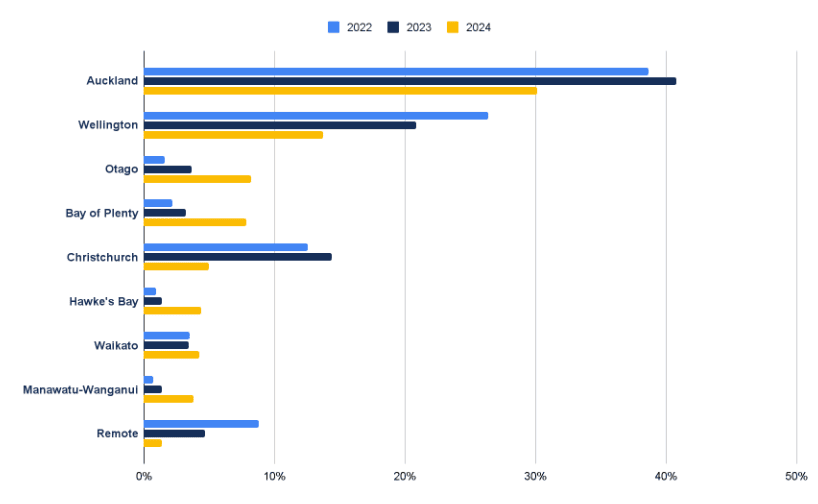
In the meantime, interest in regions like Otago, Bay of Plenty, and Hawkes Bay have gone up significantly, likely driven by factors such as lower cost of living, improved work-life balance, reduced traffic, and more opportunities.
In Hawkes Bay and Gisborne, the surge in opportunities, particularly in construction following the cyclone, may also be contributing to this trend.
It's encouraging to see more students aspiring to work in regional areas. This trend is promising for employers who often face challenges recruiting in rural locations.
It’s also worth noting that students are showing decreasing interest in remote work compared to previous years, as shown at the bottom of the chart.
We asked students, "When searching for an internship or graduate job, how important are the following factors to you?" The responses were ranked from most to least important:
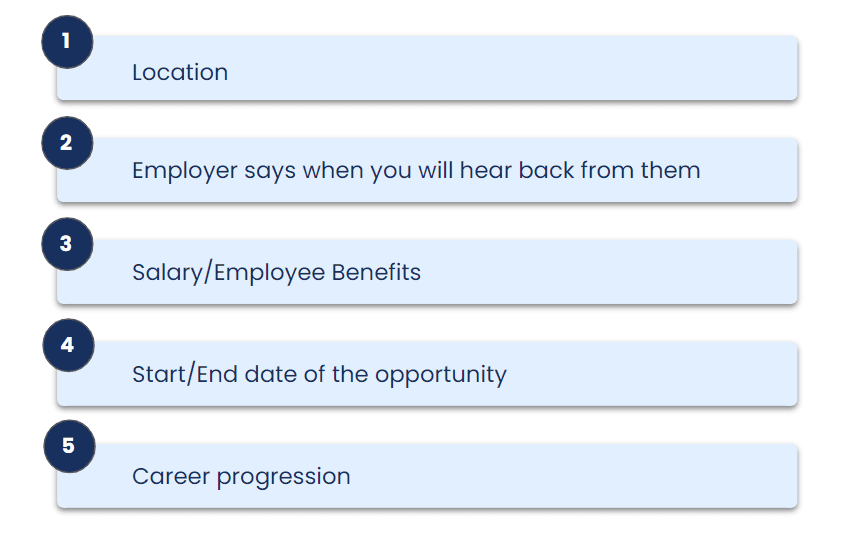
- Location is students’ top priority. There’s growing interest in regional roles and diminishing interest in cities and remote work.
- Students want to know when they’ll hear from you. Remember: Gen Zers are accustomed to instant updates and feedback. They will move on if they don’t hear back.
- Salary & benefits are top of mind for Gen Z. This is a trend that started during the COVID-19 pandemic, which likely made students more sensitive to how quickly the economy can change. So make sure your salary & benefits are clearly listed!
- Students want to plan ahead. This is why it’s important to clearly outline start and end dates as well as a career progression.
In addition to understanding students’ priorities, we asked them: “When reading a job description, how often do the following factors deter you from applying?” The responses were ranked from most to least important:

Students often choose not to apply if they think they do not meet the qualifications for the position. They might also self-eliminate if they feel the role is not inclusive or if their degree or socioeconomic background differs from what they perceive as typical for the role.
Another factor that deters them is when the job description lacks clarity and relevant details about the responsibilities involved.
Employers should create job descriptions with concise, bullet-pointed information to clearly outline the role's key tasks and expectations. This approach helps students quickly understand the job requirements and how their skills align with the position.
Tips for responding to these trends
Consider recruiting outside of peak period
Although March typically sees the most individual job searches, employers should consider extending their visibility beyond this period. Broadening recruitment efforts outside the usual timeline can engage students who don't apply during peak times, offering employers a competitive edge in attracting top talent.
Speak Gen Z's language
Creating short but impactful videos that showcase your company and employee stories are far more engaging than job postings with lots of text. If there’s one thing that Gen Zers like, it’s authenticity. Be direct, avoid corporate speak, and highlight the benefits they can get from the job.
Make it easy for them to apply
Positive candidate experience starts when employers streamline their recruitment process, especially for students applying for jobs and internships. Reduce the clicks by ensuring employers can redirect them seamlessly from one page to another.
Track your return of investment
To effectively measure and analyse your digital activities, apply click trackers to all your online interactions and utilise the applicants tab for your Prosple activities. When engaging with students, ask them where they first heard about the opportunity, ensuring the question allows for multiple selections. Additionally, track the number of students you interact with at on-campus events using unique QR codes for each event. Finally, compare your findings to market data to gain valuable insights.
Craft high conversion jobs
Start by creating an engaging brand that captures attention and resonates with potential candidates. Offer flexible work options to appeal to a wider audience, and avoid standard openings to stand out from the competition. Highlight a high salary to attract top talent and consider campaigning outside of peak periods to maximise visibility. Additionally, a strong graduate brand and above-market reviews can enhance appeal, and beginning the ad with "what's in it for them" can immediately engage and motivate candidates to apply.
Boost your jobs
With thousands of jobs advertised during key recruitment periods, visibility is crucial. Fewer students browse multiple pages, so ensure your jobs are visible during peak times.
Summary
Staying attuned to the evolving needs and preferences of students and graduates is essential for employers seeking to thrive in the competitive field of graduate recruitment. By leveraging diverse strategies and adapting to these trends, you can enhance your ability to attract and retain top-tier talent, ensuring long-term organisational growth.
To attract more applications and increase employer branding, book a strategy session with one of our Graduate Attraction Consultants today.
The slide deck
Check out the data discussed in this article in our slide deck from the webinar.


